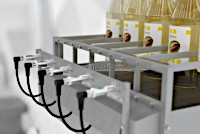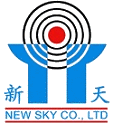Reliable Container Detection Under Vibration and High Throughput Conditions

The Application
Filling lines in the beverage industry operate at high throughput rates and are therefore highly automated. The situation is similar in the detergent and cosmetics industries, where numerous products are filled into various containers. The filled bottles pass through bottle aisles on their way to the packaging station. At the final position, their presence in each aisle is monitored separately. Only when each bottle is in the correct position will the infeed be activated via a robot arm. Otherwise, there is a risk of incomplete packs or even harm. In the machines, several aisles are usually arranged next to each other, so a correspondingly large number of sensors work in parallel in a confined space.
The Goal
The sensors must reliably and accurately detect the presence of the bottles at the end positions, at high machine speeds and with constant vibration. The bottles can be made of different materials (glass, plastic, ceramic); their colors vary; they can be transparent or have reflective surfaces. The function of the sensors must not be impaired by such properties. At the same time, the sensors must fit into a small space and must not interfere with each other’s detection.
The Solution

UC18GS Ultrasonic Sensor Series
UC18GS series ultrasonic sensors reliably detect the presence of bottles in the end positions. Instead of taking a point-by-point measurement, their sound beam hits the surface of the container over a wide area. This ensures detection even with varying contours and position deviations and makes the color and texture of the container surfaces irrelevant. The output configuration as well as the sound beam radius can be set with push buttons on the device. The IO-Link interface allows comprehensive parameterization via the controller without physical access to the sensor. This not only makes commissioning particularly easy, but also enables fast product changeover without time-consuming re-parameterization. Even the complete individualization of products—automated production in batch size 1—is possible via IO-Link.
Technical Features:
- Measuring range up to 1000 mm
- Very small dead bands of 30 mm resp. 70 mm
- Interfaces: IO-Link 1.1, infrared interface IrDA
- Output types: 2x push-pull switching output or 1x push-pull switching output and 1x analog output (current/voltage)
- Ambient temperature: –25 to +70 °C
- Degree of protection: IP67
The Benefits
When several devices are mounted close to each other, they will automatically synchronize their sound signals and avoid interfering. Up to ten sensors can be connected via their synchronization input. Sensor synchronization takes place automatically and without parameterization. With its compact dimensions, a minimum blind zone and a range of one meter, the sensor affords tremendous freedom when mounting it on the machine. The device offers a wide range of functions including interference target suppression, flexible sound beam, automatic synchronization, minimum dead band, IO-Link and infrared interface as well as push buttons for basic settings. Users also benefit from comprehensive application know-how and future-proof sensor solutions.
At a Glance
- Reliable detection of irregular shapes
- Independent of optical properties and surface conditions
- Space-saving design for installation in confined spaces
- Multiplex function for parallel operation of several sensors
- IO-Link allows easy commissioning via remote access





